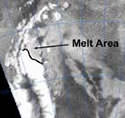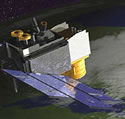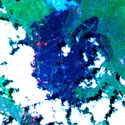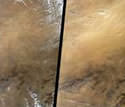
Image credit: NASA
An instrument on board NASA’s Quick Scatterometer spacecraft has detected the earliest melting in Antarctica’s Larsen Ice Shelf. This huge plate of glacier-fed ice has been disintegrating since 1995, losing nearly 10-percent of its size (more than two trillion tonnes of ice), and the most recent chunk disappeared due to a cyclone that sent warm weather into the area.
An international research team using data from NASA’s SeaWinds instrument aboard the Quick Scatterometer spacecraft has detected the earliest yet recorded pre-summer melting event in a section of Antarctica’s Larsen Ice Shelf. This huge, nearly 200 meter (656 foot) thick plate of glacier-fed floating ice, which in the late 1980s was about as large as Indiana, experienced dramatic disintegration events beginning in 1995 that have reduced its area by nearly 10 percent, or more than two trillion tons of ice.
Researchers Dr. Mark Drinkwater of the European Space Agency, Dr. David Long of Brigham Young University and Dr. Steve Harangozo of the British Antarctic Survey used near real time Quick Scatterometer (QuikScat) data to document a rapid, extensive melting of the Larsen C Ice Shelf in Antarctica’s Weddell Sea from Oct. 27 to Oct. 29, 2002. The melting, which extended to 68 degrees south, was triggered by a mid-latitude cyclone that delivered warm air to the region. The same storm is believed to have also caused a noticeable recession in the sea-ice margin to the west of the Antarctic Peninsula. The QuikScat images are available at: http://photojournal.jpl.nasa.gov/catalog/PIA03894
Air temperatures in the region typically exceed freezing for a few days on or after November 1 each year-a precursor to sustained summer melting that normally sets in several weeks later at these latitudes. The cumulative duration of these annual summer melting events is likely to have increased substantially over the past 50 years as summer average air temperatures on the eastern side of the Antarctic Peninsula have warmed appreciably (approximately two degrees Celsius, or 3.6 degrees Fahrenheit). Scientists believe these events are responsible for the previous breakups of Larsen and other ice shelves. Therefore, the ability to observe such events in near real time using scatterometers is of great interest to researchers, since they may provide invaluable clues to the fate of other, much larger Antarctic ice shelves.
While scientists used to believe there was no connection between recent Antarctic Peninsula warming and the natural cycle of deglaciation, recent field measurements provide some evidence to suggest the frequency of summer melting, and the resulting quantities of melt water penetrating ice shelves, may be connected with the accelerated disintegration of Larsen and other Antarctic ice shelves.
“The water is believed to penetrate cracks and fissures in the ice and refreeze at depth, where the ice is relatively colder,” said Drinkwater. “As the ice expands, this process effectively drives a wedge into existing cracks to accelerate the natural fracture process.”
Scatterometers operate by transmitting high-frequency microwave pulses to Earth’s surface and measuring the “backscattered,” or echoed, radar pulses bounced back to the satellite. Moshe Pniel, scatterometer projects manager at NASA’s Jet Propulsion Laboratory, Pasadena, Calif., which developed and manages the instruments, said scatterometers such as SeaWinds on QuikScat and a similar SeaWinds instrument on Japan’s recently launched Advanced Earth Observing Satellite 2 (Adeos 2), are proving to be increasingly important in monitoring land and ice processes.
“Scatterometers can effectively and quickly detect the difference between melting and dry surfaces,” he said. “They provide an important new tool in our capability to monitor climate change impacts on the Antarctic ice cover on a daily basis. These scatterometer data are vital in the southern hemisphere because near real time synthetic aperture radar data is not available there on a frequent, uninterrupted basis. QuikScat measurements being compiled and archived in the Scatterometer Climate Record Pathfinder study by Long and Drinkwater (http://www.scp.byu.edu) enable critical assessments of the links between changes taking place in global ice cover and associated changes in important elements of Earth’s closely-linked ocean-atmosphere climate system.”
QuikScat measurements and image data developed by Long are processed and distributed in near real time by the National Oceanic and Atmospheric Administration, providing scientists at the British Antarctic Survey and elsewhere with rapid access to low-resolution radar data that can be used to report melt events. The British Antarctic Survey compiles and distributes Antarctic Meteorological Station data in near real time.
More information about SeaWinds is available at: http://winds.jpl.nasa.gov/index.html.
NASA’s Earth Science Enterprise is a long-term research effort to understand and protect our home planet. The California Institute of Technology in Pasadena manages JPL for NASA.
Original Source: NASA/JPL News Release



